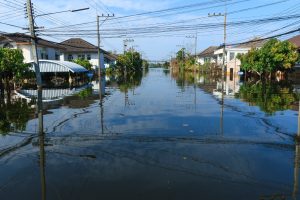 Category 4 Hurricane Ida (now downgraded to a tropical storm) on Sunday smacked the central Louisiana shore—so strong it knocked out power to all of New Orleans and temporarily reversed the flow of the Mississippi River—before barreling through heavily populated residential and industrial areas spanning three southern states.
Category 4 Hurricane Ida (now downgraded to a tropical storm) on Sunday smacked the central Louisiana shore—so strong it knocked out power to all of New Orleans and temporarily reversed the flow of the Mississippi River—before barreling through heavily populated residential and industrial areas spanning three southern states.
Property data providers at CoreLogic reported that some 941,392 homes in Louisiana, Alabama, and Mississippi could be exposed to storm surge damage from Ida, causing an estimated worst-case reconstruction cost value of approximately $220.37 billion. Note: those estimates are based on an analysis just before the storm hit and also assume 100% damage to a property; CoreLogic will update those numbers as real damage becomes available on hazardhq.com). CoreLogic reported Monday afternoon that "the maximum surge heights are still unknown, and it may take several days to understand the true impact."
Ida is so large and intense—with damaging winds between 130-156 mph, life-threatening storm surge of up to 15 feet, and extremely heavy, widespread rainfall between 10-15 inches—CoreLogic's weather experts are comparing it to the most infamous modern-era Hurricane to hit the area.
“Atmospheric conditions are highly favorable for rapid intensification after Ida emerges from Cuba on Saturday into Sunday,” said Daniel Betten, Meteorologist and Senior Leader for Weather Science at CoreLogic. “Ida will also be passing over an extremely warm loop current, which is known to contribute to the rapid intensification of hurricanes in the central Gulf of Mexico, most famously seen with Hurricanes Katrina and Rita in 2005.”
Hurricane Ida is the fourth named hurricane of the 2021 season and the first Cat 4.
The 2021 Hurricane Report from CoreLogic revealed almost 8 million homes with more than $1.9 trillion in reconstruction cost value at risk of storm surge damage throughout the 2021 hurricane season.
Focused on both single and multifamily residences along the Gulf and Atlantic coasts, CoreLogic documented a significant spike in mortgage delinquency rates and loss in inventory after a hurricane strike. It also studied impact of hurricanes on the nation's housing supply, which is already alarmingly short.
After Harvey, Houston, Texas experienced a 23% decrease in its supply over the next five months. Wilmington, North Carolina lost 26% of its stock in four months following Florence in 2018. Panama City, Florida's inventory dipped 13% in the two months after Hurricane Michael in 2018—all data outlined in CoreLogic's report.
The increase in mortgage delinquency rates results from things one might expect—damage expenses, lost wages. After Hurricane Laura made landfall in Lake Charles, for example, the already-elevated delinquency rate went up from 9.8% in August 2020 to 16.1% in September 2020, an increase of 6.3 percentage points, according to the report.
As Ida struck, GSEs FannieMae and Freddie Mac reminded those impacted by hurricanes, fires, and all manner of natural disaster, of available mortgage assistance and relief options.
Fannie Mae reports: Mortgage servicers are authorized to offer forbearance for up to 90 days—even without establishing contact —if the servicer believes the homeowner was affected by the disaster. Homeowners affected by a disaster are often eligible to reduce or suspend their mortgage payments for up to 12 months sans late fees or threat of foreclosure. There are a number of options available to potentially help homeowners catch up on missed payments, including Disaster Payment Deferral.
Freddie Mac’s VP of Single-Family Servicing Portfolio Management, Bill Maguire, says that, along with its mortgage servicers, "Freddie Mac stands ready to provide immediate mortgage relief options to those affected by Hurricane Ida."
Freddie's disaster relief options are available to homeowners whose homes or places of employment are located in presidentially-declared Major Disaster Areas.
Maguire added, “Once safe, homeowners whose homes are impacted should contact their mortgage servicer—the company they send their monthly mortgage payments to— as soon as possible to talk about available mortgage relief options. This also includes homeowners whose places of employment have been impacted resulting in a financial hardship that prevents them from being able to make their monthly payment.”
As climate change continues to affect the way storms present, the risk in these hurricane-prone areas will continue to increase, according to CoreLogic's authors: Tom Larsen, Thomas Jeffery, Rhea Turakhia, Denise Moore, Molly Boesel, Elizabeth Greeves, Maiclaire Bolton Smith, and Jose Acosta.
They note: "Based on data from NOAA National Centers for Environmental Information, over the past four decades we've seen a 70-90% increase every decade in total inflation-adjusted losses from weather events in the United States—and this trend isn’t slowing down."
They say the trend toward migrating out of city centers to coastal towns, which emerged during the pandemic-related increase in remote work, could cause more households to be at-risk.
The resilience of these coastal communities—high income or low—continues to be a focal point of prevention and preparation, the authors noted.
"The only way forward is to understand what really is at risk and educate, prepare and collaborate with everyone who has a stake in the ongoing crisis, including insurance companies, lenders, government agencies, and the families on the front line," they added.
Access the full report via CoreLogic.com.

 DSNews The homepage of the servicing industry
DSNews The homepage of the servicing industry









